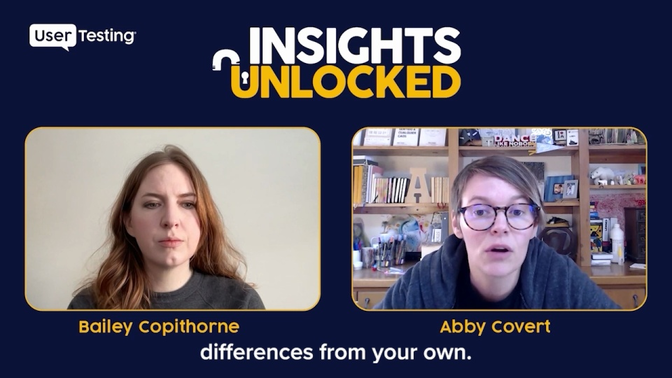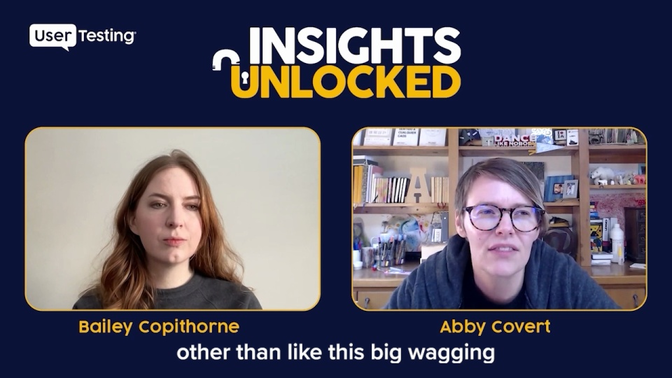
Episode 117 | May 13, 2024
How to demystify Information Architecture for improved user experiences
In this week’s Insights Unlocked, Abby Covert talks with Bailey Copithorne, UserTesting’s manager of product design. They discuss what information architecture is, why it’s important for organizations and individuals, how it impacts UX design and digital products, and how IA will leverage AI in the future.
How to demystify Information Architecture for improved user experiences
Ever have a coffee filter malfunction?
It can be a bit of a buzz kill.
Like a coffee filter, says Abby Covert, information architecture (IA) actively sorts and organizes complex information, ensuring users receive only the most relevant and digestible content, thereby enhancing clarity and usability.
"An information architect has to be more like a coffee filter, filtering out the stuff that's not drinkable for other people," she said.
In this Insights Unlocked episode, Abby talks with Bailey Copithorne, UserTesting’s manager of product design. They discuss what information architecture is, why it’s important for organizations and individuals, how it impacts UX design, and how IA will leverage AI in the future.

Abby is an information architect who helps people make sense of information. She’s a speaker, teacher, and the author of How to Make Sense of Any Mess, as well as Stuck? Diagrams Help. She is also the founder of The Sensemakers Club, a digital clubhouse where you can meet sensemakers with similar interests and challenges to your own.
Her approach demystifies the often-intimidating aspects of information architecture, presenting it in a way that is not only comprehensible but also actionable. Throughout the podcast, Abby emphasizes that good information architecture isn't just about organizing content; it's about aligning it with the user's intentions and needs.
Why Information Architecture is important
Information architecture is crucial for UX designers and others because it helps organize and structure content in a way that makes it easy for users to navigate, understand, and interact with a product or service effectively, enhancing overall user experience.
“We all face messes and it really doesn't matter what your job title is, you're going to run into something that is a mess made of information and people at some point,” she said.
What is Information Architecture in UX design?
Information Architecture (IA) refers to the way content is presented and accessed from any given page on your website – whether through menus, breadcrumbs, categories, or links.
A good IA can help people on your site understand where they are, what’s around, and what to expect.
Information Architecture typically focuses on:
- Structure: the way information is laid out i.e. people should be able to predict where to find what they’re looking for
- Organization: grouping information in a way that makes sense to people
- Labels: ensuring elements are appropriately titled so people can find information
For more information, read this UserTesting blog post, Information architecture: a comprehensive UX guide for beginners.
An information architecture rubric for leveraging customer feedback
“Whether it's customer feedback, stakeholder feedback or any type of information, how do you leverage the feedback and apply it to the art of crafting this IA?,” Bailey asked Abby.
Abby told a story from her time at Etsy. She was about six months into working there when her boss brought a voice-of-the-customer project to her that had been developed by a colleague no longer there. He wanted to know if she could do something with it.
What she had found was that different teams and different channels within the organization had their lists of what customers had identified as problems or challenges. But that information was siloed within those teams unless it popped up in a keynote presentation at the monthly or quarterly meeting.
“This is like such an interesting information architecture dilemma,” she said. “There was just like a lot of missed connections across these things.”
She brought together a cross-functional team and combined the lists. “And then we were like, ‘OK, now we have a list of all the things that's wrong.”

“What we decided to do was make a rubric that was based on both the user value and the perceived volume of the problem,” Abby said. “How much are people talking about it and how bad is it for folks? And then we did that by different user segments.”
Using the rubric, she said, they calculated the organizational value of fixing things on that big list and prioritized what would (and would not) get done. It was a systemized approach to thinking about all of these disparate information points (each team’s list of customer feedback) and how they brought them into one place to be prioritized against each other, Abby said.
“And once there was ownership on those issues and a score, and the score was going in a direction either up or down,” she said, “it was very clear what was having momentum towards progress and what wasn't.”
What are the biggest challenges people face when trying to make sense of information?
Abby said perhaps the biggest challenge is making people understand that there is no shortcut or silver bullet to making sense of the mess. Likewise, you can’t just copy what some larger or more sophisticated organization is doing and assume that will work for you, too. And if those patterns did exist, Abby said, they are likely pretty transient and ever changing.
“There isn’t some handbook that we’re not giving you, there isn’t some bag of tricks you haven’t paid for yet, there isn’t some software that you can hit the button and it does it for you,” she said.
And, she said, that is very ambiguous for some people. “It’s not as science as it is art.”
Introducing IA to teams where the concept may be new
But with so many ways to understand and organize that information, how do you get started?
“I think a lot of times when we talk about mental models and design, we have an easier time grasping that we're talking about the mental models of our users,” she said. “But I think that the mental models of our stakeholders are almost more impactful and absolutely more immediately impactful on the work that we can get done for those eventual end users.”

“I feel like when you're looking for the reconciliation, oftentimes I find that’s in the stakeholder process. It's in understanding the people that you're working with or for, understanding their mental model differences from your own, realizing that none of us come into any of these problems without our own bias and our own idea of what the solution should be.”
That’s why an information architect has to be more like a coffee filter, she said. “And that's a dirty job, right? It's kind of thankless. And you get thrown away at the end,” she said. “But I do think that it's the way that you can reconcile those differences that you're talking about.”
What is the future of information architecture?
Bailey asked Abby how she saw Information Architecture evolving over the next few years? And, she asked, how might we leverage AI in the field of information architecture?
Abby said she believes that information architecture is one of the keys to the future of AI and machine-learning tools being human consumable.
“Humans are very finicky, and trust is definitely built on that finicky-ness,” she said. “So if we're going to trust these machines to do our business for us, if we're going to trust them to take on major aspects of our lives, we're going to need them to prove that they actually understand being human. And we're the best people to teach them that.”
Making sense of the mess: The Sensemakers Club?
She created The Sensemakers Club for those seeking a community of other information architects and others who are seeking to make sense of a mess.
“Sensemaking can be lonely work and often the folks doing that sort of work lack a wider community with which to draw lessons and support,” Abby said.
She is hoping to scale up the group and recently recruited 40 discussion leaders who will soon begin a daily discussion each weekday. To learn more or get involved, visit The Sensemakers Club website.
“I don’t believe that information architecture is magic. And I don’t believe it’s hard,” Abby said. “I think that everything you apply it to can get really challenging. And I think the things themselves are really challenging. But I think IA at its basis is something that most people can apply to their work, all people can apply it to their life, and most people could benefit from getting better at.”










